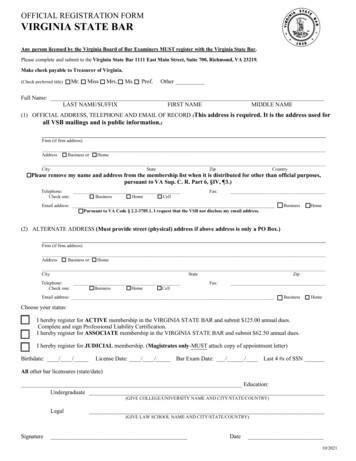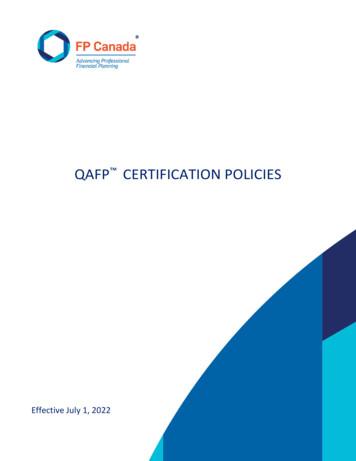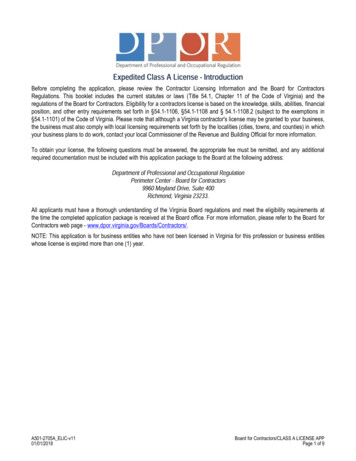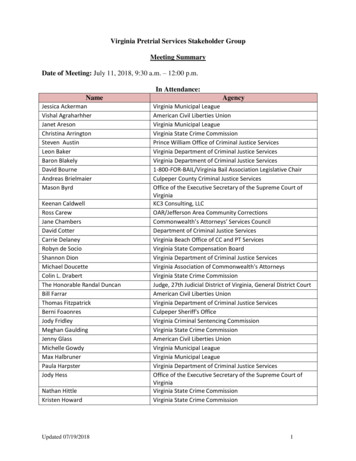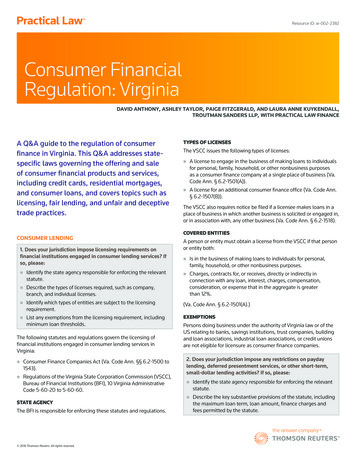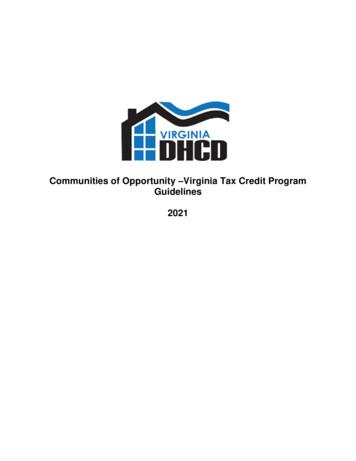
Transcription
Virginia Department of Criminal Justice ServicesForfeited Asset Sharing Program1100 Bank Street, 12th FloorRichmond, Virginia 23219804-371-0538 FAX: 804-786-0053Virginia Annual Certification Report and Sharing Agreement InstructionsPlease retain these instructions for your records.DO NOT SUBMIT WITH REPORTLaw Enforcement Agency InformationName of Agency: Enter the complete name of your state or local law enforcement agency (ex: Anytown PoliceDepartment). Check the appropriate box to indicate type of agency. Acronyms should be spelled out.Contact Person: Enter the name of the person in your agency DCJS may contact regarding this report if there are anyquestions. They must have knowledge of the report content.Email: Enter the email address of the contact person.Mailing Address: Enter your agency’s complete mailing address (number, street, city/town, state, zip code).Phone Number: Enter the phone number of the contact person, including area code and extension. This number must be adirect line to the contact person.Federal Identification No.: Enter your locality’s valid Federal Identification Number.Fax Number: Enter your agency’s fax number, including area code.Summary of Asset Forfeiture Fund Activity1. Beginning Asset Forfeiture Fund Balance: Enter on line 1 the amount in your state asset forfeiture account atthe beginning of the fiscal year. (This is the previous year’s ending balance and should be the same amountas reported on line 10 of the previous year’s report.)2. State Asset Forfeiture Funds Received from DCJS: Enter on line 2 the total amount of cash and/or proceedsreceived from Virginia’s Forfeited Asset Sharing Program. The fiscal year runs from July 1 to June 30 of thereporting year. This must be the same amount as on the Disbursal Summary Report unless there was anadjustment during the fiscal year.DO NOT INCLUDE CHECKS OR FUNDS REFUSED BY DCJS AND RETURNED TO YOUR AGENCYIN THIS LINE OR ANYWHERE ELSE ON THE REPORT.3. State Asset Forfeiture Funds Received from DCJS as a Fiscal Agent for a Task Force: Enter on line 3 if youare a County, City or Town Treasurer or State Agency Finance Division and received proceeds directly fromDCJS while acting as a pass through for a task force. For example, Augusta County Treasurer receives fundsfor Skyline Drug and Gang Task Force (separately from the Sheriff’s Office). Augusta County Sheriff’sOffice will report the total on line 3.Virginia Annual Certification Report and Sharing Agreement Instructions (Rev. 07/2021)1
4. Other Income Transfers from Other Agencies: Enter on line 4 if you have received funds from another agencyor are a Task Force who has received funds from a County, City or Town Treasurer or State Agency FinanceDivision mentioned above who acted as a fiscal agent on your behalf. (This line is NOT for funds received under 500 or proceeds from sold assets.) Attach an itemized list of receipts. For example, Augusta County Treasurertransfers funds to Skyline Drug and Gang Task Force. Skyline would submit a list of the transfers the taskforce received FROM August County, and the total would be on Line 4.5. Other Income: Enter on line 5 the proceeds from the sale of forfeited property that was sold for under 500.00within 1 year from the court order of forfeiture (for assets seized after 8/1/04), or was sold more than 1 year afterthe court order of forfeiture date. In addition, all forfeitures your agency received under the 500 minimumshould be reported on this line.Example 1: Norfolk Police Department handles multiple currency forfeitures under 500 and sells six carsmore than a year after the court order of forfeiture date. Norfolk PD will enter the total of these forfeitureson line 5 and list each case and the amount received per case on an itemized list similar to the one below.Norfolk PD will also enter the total amount transferred TO other agencies on line j, and submit a similarlist showing the transfers to other agencies.Example 2: Norfolk Commonwealth’s Attorney’s Office receives transfers from Norfolk PD for the abovecases under 500 and cars sold. The Commonwealth’s Attorney’s Office will enter the total received fromthe PD on line 5 of their report and submit a list in the format below showing the individual transfers.The list attached for this line should be in the following format:Line 5—List FormatCase NumberName on CaseAsset DescriptionAmount Rec'dSource (agency from which the fundswere received)6. Interest Income Accrued: Enter on line 6 the interest earned on your state asset forfeiture fund account duringthe fiscal year. Attach documentation showing how the interest earned was determined. If funds are in a noninterest bearing account, please indicate so here.7. Adjustment to Income that was not reported on Prior Fiscal Year Certification Report: Attach anexplanation for the adjustments on agency letterhead including amount(s) and explanation(s) for each instance.8. Total Asset Forfeiture Funds: The total amount auto-calculates by a formula on line 8 for lines 1-7.9. State Forfeiture Funds Spent: (total for lines a-k, which calculates on line l) DO NOT enter manually—this line will auto-populate from line l.10. Asset Forfeiture Fund Balance: This fund amount at the end of FY2021 must be in agreement with the treasureraccounts of your City, County, Town or State Finance Division at the end of the fiscal year as recipients of thefunds.Virginia Annual Certification Report and Sharing Agreement Instructions (Rev. 07/2021)2
Summary of Monies SpentIn this section, agencies will report on expenditures of state asset forfeiture funds. Expenditures must comply withthe Virginia State Code and the Forfeited Asset Sharing Program Manual (including Criminal Justice ServicesBoard Rules and Regulations) located at ing-program. Allexpenditures are subject to laws, rules, regulations, and orders of the state or local jurisdiction governing the use of publicfunds available for law enforcement purposes.§ 19.2-386.14. Sharing of forfeited assets.D. All forfeited property, including its proceeds or cash equivalent, received by a participating state or localagency pursuant to this section shall be used to promote law enforcement but shall not be used to supplantexisting programs or funds. The Board shall promulgate regulations establishing an audit procedure toensure compliance with this section.This Annual Certification Report and Sharing Agreement is the first step of the audit procedure. All agencies must complywith the reporting requirement to remain certified in the Forfeited Asset Sharing Program. Agencies who do not submittheir Annual Certification Report and Sharing Agreement by September 30th will have their disbursements withheld untilthey comply with all requirements.Categoriesa. Total spent on salaries: Asset Forfeiture funds may be used for salaries of employees in certain situations. Theseinclude overtime payments, first year salaries only for new law enforcement officers that supplement theworkforce, contractual appointments that do not exceed one year, salaries of officers in non-traditional positionsin approved specialized programs, COPS program local match, and salaries of sworn law enforcement officershired to replace officers assigned to a federal task force. Attach an itemized list showing the individual(s) whoreceived payment, what the payment was for, the amount of the payment(s), and the date of thepayment(s).b-i. For each item below, attach a list of expenditures with the categories used as headings. This list should beitemized by the date, identifying details of the expenditure, the amount, the recipient of the funds (vendor), andwhy it is a law enforcement expense if it is not obvious.DO NOT INCLUDE COPIES OF INVOICES, BUT KEEP FOR YOUR RECORDS.b. Total spent on informants and “buy money”: if possible, buy money should be deposited back into the assetforfeiture fund account if asset forfeiture funds were used. Provide a list of cases, dates and amounts.c. Total spent on travel and training: the training of investigators, prosecutors, and law enforcement supportpersonnel in any area that is necessary to perform official law enforcement duties. Some examples of suchtraining are the following: (1) asset forfeiture in general; (2) the Fourth Amendment (search and seizure, probablecause, drafting affidavits, confidential informant reliability); (3) ethics and the National Code of ProfessionalConduct for Asset Forfeiture; (4) due process rights; and (5) protecting the rights of innocent third-parties. Thepayment of college tuition, hospitality suites at conferences and other indirect training expenses are notallowed.d. Total spent on communications and computers: the purchase of radios, cell phones, computer equipment, andsoftware used in support of law enforcement purposes. This may include monthly payments for cell phones.e. Total spent on firearms and weaponsf.Total spent on body armor and protective gearVirginia Annual Certification Report and Sharing Agreement Instructions (Rev. 07/2021)3
g. Total spent on electronic surveillance equipment: includes body cams and softwareh. Total spent on buildings and improvements: the costs associated with basic and necessary facilities, theirconstruction, updating, remodeling, furniture, safes, file cabinets, telecommunications equipment, etc., that arenecessary to perform official law enforcement duties; detention facilities cost associated with construction,expansion, improvement or operation if managed by the agency; and pro rata funding of buildings andimprovements. Capital improvement expenses are only approved for buildings owned by the agency orlocality.i.Total spent on other law enforcement expenses: may include drug education and awareness programsconducted by the law enforcement agency; asset accounting and tracking costs; uniforms; supplies; leasing ofoffice and other space for task force and undercover operations; and other leases or purchases that support lawenforcement activities.j.Total transfers to other law enforcement agencies: list transfers of percentages of proceeds received under 500, proceeds for property sold more than one year after court order of forfeiture, or any other transfer.Example: Norfolk PD in line 5 received forfeiture proceeds from cases under 500 and auctioned vehicles.Their sharing agreement requires them to share 25% of asset forfeiture funds with the Commonwealth’sAttorney’s Office. The PD will enter the total transferred to the Commonwealth’s Attorney’s Office on linej, and submit a list of the individual transfers in the format below. The Commonwealth’s Attorney’s Officewill list the transfers received on line 5 as indicated above.DO NOT INCLUDE FORFEITED FUNDS SENT TO DCJS FOR DISBURSEMENT IN THIS LINE ORANYWHERE ELSE ON THE REPORT.Line J—List FormatCase NumberCase NameAsset DescriptionAmountTransferredReceived By (law enforcementagency to which the funds weretransferred)k. Adjustment to Monies Spent that was NOT reported on the prior fiscal year Annual Certification Report:Enter on line k any purchases that should have been on the prior year report and were not. Attach an explanationof the reason for the adjustment on agency letterhead.l.Total of Monies Spent (totals equal line a-k) Do not enter manually. This field will auto-calculate after theamounts on the lines above are entered.Virginia Annual Certification Report and Sharing Agreement Instructions (Rev. 07/2021)4
Supplemental Information:Totals of other funds required for DCJS Annual Report1. Total forfeited amounts sent to the State Literary Fund: Enter the total your agency sent to the Literary Fundfor non-drug related cases or those which did not meet the requirements by code to send to DCJS. Do not includefunds sent to Abandoned or Unclaimed Property. Itemized lists are not required for certification reporting.2. Total forfeited amounts received from the Federal Equitable Sharing Program: Enter the total your agencyreceived from federal agency sharing of forfeited asset proceeds. Do not include funds from federal sourcesthat are deemed as support for special programs.Per § 19.2-386.14 (F), effective in FY2019: Any state or local agency that receives a forfeited asset or anequitable share of the net proceeds of a forfeited asset from the Department or from a federal asset forfeitureproceeding shall inform the Department, in a manner prescribed by the Department, of (i) the offense on whichthe forfeiture is based listed in the information filed pursuant to § 19.2-386.1, (ii) any criminal charge broughtagainst the owner of the forfeited asset, and (iii) if a criminal charge was brought against the owner of theforfeited asset, the status of the charge, including whether the charge is pending or resulted in a conviction.Per the above code section, if your agency received federal asset forfeiture funds, you must submit the followinginformation on a spreadsheet for each case. This information will be included on the Annual Report to theGovernor and General Assembly:a. Law Enforcement Agency case number: either locality or federal case numberb. What was the basis for the seizure? List a code section or description (ex: distribution of illegal narcotics)c. Defendant’s name: list all defendants related to this forfeitured. All criminal charges for each defendant that are related to this forfeiture: use code section or descriptionof chargee. Status of each criminal charge: conviction, pending, fugitive, etc.f. Notes: may include any relevant information, particularly attempts to determine information about theforfeiture if unsuccessful#2—Spreadsheet Format ExampleCase NumberBasis for SeizureDefendant’s Name(1 per line)Criminal Charges(1 per line)Status of ChargesNotesCertificationLaw Enforcement Agency Head: The head of your law enforcement agency (or an authorized representative) must sign and date the form.(Examples of law enforcement agency head or authorized representative include the following: police chief,sheriff, Commonwealth’s Attorney, etc.). Name and title of the signatory must be printed or typed. By signing the Annual Certification Report and Sharing Agreement, the head of the law enforcementagency (or the authorized representative) certifies that this report is an accurate account of funds receivedand spent by the law enforcement agency during this reporting period. In addition, he/she certifies that allmonies received have been deposited and accounted for consistent with applicable state laws, FASPregulations, and court orders, and that all property transferred and all proceeds have been used topromote law enforcement and have not supplanted existing funds.Virginia Annual Certification Report and Sharing Agreement Instructions (Rev. 07/2021)5
Governing Body Head: The head of your governing body (or an authorized representative) must sign and date the form. (Examples ofgoverning body head or authorized representative include the following: city manager, county administrator,mayor, etc.). Name and title of the signatory must be printed or typed. By signing the Annual Certification Report and Sharing Agreement, the head of the governing body (or theauthorized representative) certifies that this report is an accurate account of funds received and spent bythe law enforcement agency during this reporting period. In addition, he/she certifies that all moniesreceived have been deposited and accounted for consistent with applicable state laws, FASP regulations,and court orders, and that all property transferred and all proceeds have been used to promote lawenforcement and have not supplanted existing funds. For purposes of this form, a governing body is an institution or organization that has appropriations authority (theagency that gives your agency its budget) over the state or local law enforcement agency. A law enforcementofficial should not sign for the governing body unless he/she has appropriations authority.County or Town Treasurer: The Treasurer of your locality (or an authorized representative) must sign and date the form. Name and title of thesignatory must be printed or typed. By signing the Annual Certification Report and Sharing Agreement, the Treasurer (or the authorizedrepresentative) certifies that this report is an accurate account of funds received and spent by the lawenforcement agency during this reporting period. In addition, he/she certifies that all monies received havebeen deposited and accounted for consistent with applicable state laws, FASP regulations, and courtorders, and that all property transferred and all proceeds have been used to promote law enforcement andhave not supplanted existing funds.Additional Officer (optional): This signature space is included if your organization requires or desires an additional signatory. For example, ifthe Finance Director is preparing the report with input from the Treasurer and Law Enforcement Agency Head,the Finance Director should sign here. Name and title of the signatory must be printed or typed. By signing the Annual Certification Report and Sharing Agreement, the Additional Officer certifies thatthis report is an accurate account of funds received and spent by the law enforcement agency during thisreporting period. In addition, he/she certifies that all monies received have been deposited and accountedfor consistent with applicable state laws, FASP regulations, and court orders, and that all propertytransferred and all proceeds have been used to promote law enforcement and have not supplanted existingfunds.DUE DATE: SEPTEMBER 30THYou may MAIL or email the Annual Certification Report(Signatures of all parties are required. No signature stamps will be accepted.)Email to: fasp@dcjs.virginia.govMail to: Virginia Department of Criminal Justice ServicesForfeited Asset Sharing Program1100 Bank Street, 12th Floor, Richmond, Virginia 23219For questions, please contact the DCJS staff at(804) 371-0538 or (804) 786-4249 or fasp@dcjs.virginia.govFASP regulations require program participants to keep records for three years plus the current fiscal year.Virginia Annual Certification Report and Sharing Agreement Instructions (Rev. 07/2021)6
Virginia Annual Certification Report and Sharing Agreement Instructions (Rev. 07/2021) 4 g. Total spent on electronic surveillance equipment: includes body cams and software h. Total spent on buildings and improvements: the costs associated with basic and necessary facilities, their construction, updating, remodeling, furniture, safes, file cabinets, telecommunications equipment, etc., that are
